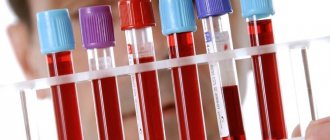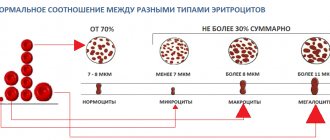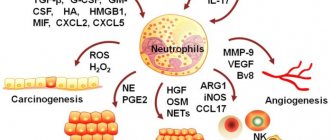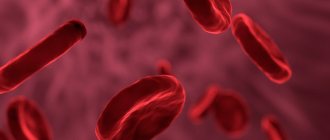Just the other day we told you a story about how an 81-year-old healthy eating enthusiast overdid it so much that he almost lost his kidneys. Judging by the statistics, this news interested many of our readers - do you want more of this? Fortunately, there are a lot of similar medical stories, and one of them happened quite recently in the American state of Rhode Island. A 25-year-old girl presented to a local hospital complaining of weakness, breathing problems and a bluish tint to her skin. During the tests, it turned out that her blood turned dark blue.
The cause of blue blood is oxygen deprivation
A doctor named Otis Warren examined the girl. Fortunately, he had extensive experience and had already seen patients with blue blood. Suspecting that the cause of the blue tint of the girl’s skin, nails and blood was oxygen starvation, the doctor decided to measure the oxygen saturation of her blood. His instinct did not let him down - while the blood oxygen saturation in a healthy person is 97-100%, in the patient this figure was 67%.
Bleeding
When providing first aid, it is important to know which blood is arterial and which is venous.
These species are easily identified by their flow patterns and color. With arterial bleeding, a fountain of bright scarlet blood is observed. The liquid flows out pulsatingly and quickly. This type of bleeding is difficult to stop, which is the danger of such injuries.
When providing first aid, it is necessary to raise the limb and compress the damaged vessel by applying a hemostatic tourniquet or pressing it with finger pressure. In case of arterial bleeding, the patient must be taken to the hospital as quickly as possible.
Arterial bleeding may be internal. In such cases, a large amount of blood enters the abdominal cavity or various organs. With this type of pathology, a person suddenly becomes ill, the skin turns pale. After some time, dizziness and loss of consciousness begin. This is due to lack of oxygen. Only doctors can provide assistance with this type of pathology.
With venous bleeding, dark cherry-colored blood flows out of the wound. It flows slowly, without pulsation. You can stop this bleeding yourself by applying a pressure bandage.
Royal disease or blue blood sign
Hemophilia is a hereditary blood disorder that is caused by a congenital absence or decrease in the amount of blood clotting factors (most often VIII or IX). The disease is characterized by a blood clotting disorder and manifests itself in frequent hemorrhages in joints, muscles or internal organs.
The disease manifests itself only in males; women are carriers of the hemophilia gene. Hemophilia in a woman occurs very rarely and only if both parents were carriers of the mutation - such cases are 1 per 100 million people. In 70% of cases, the disease is inherited, in 30% it occurs in the event of a “breakdown” of a gene, i.e. no family can be immune from the fact that a sick child may be born into it.
Previously, hemophilia was considered a “royal” disease or a sign of blue blood. Its most famous carrier was Queen Victoria, who passed the dangerous gene on to her children, and after them to her grandchildren and great-grandchildren, including Tsarevich Alexei, the only son of Nicholas II. Since in those days consanguineous marriages were considered the norm and relatives formed families to preserve titles, lands and the throne, the disease became established and was very common in various royal dynasties.
Today, about 400 thousand people in the world suffer from hemophilia. There are more than 600 such patients in Belarus. They are included in the register of blood diseases and receive therapy free of charge.
The first signs of hemophilia can be detected immediately after birth: increased bleeding in the area of the navel stump, severe hematomas on the head and body. However, it is rarely possible to detect hemophilia in infancy, since the child receives a sufficient amount of active thrombokinase through mother's milk. At a later age, parents discover incessant weak bleeding when teething, the teeth injure the oral cavity and these wounds do not heal well. The most obvious signs appear from the moment when children begin to walk independently - due to minor bruises and falls, severe subcutaneous, joint and muscle bleeding occurs. With chronic hemarthrosis (accumulation of blood in the joints), joint mobility is lost and the need for joint replacement surgery arises.
Therefore, it is extremely important to take replacement therapy from the first days of diagnosis. Treatment can prevent bleeding or reduce its effects, reducing disability. Replacement therapy is the introduction of a deficient blood clotting factor into the patient's body directly into a vein to ensure a normal level of hemostasis.
The life prognosis for current hemophiliacs is favorable, subject to constant adherence to treatment conditions. Their average life expectancy is the same as that of healthy people.
The most important preventive measure is medical and genetic counseling for those entering into marriage. Identification of female carriers of the gene is possible by determining blood clotting factors VIII or IX in their blood using a quantitative biochemical method.
General practitioner of the Healthcare Institution “Korelichskaya Central District Hospital”
Natalia Manylo
Incomplete separation of arterial and venous blood
Incomplete separation of arterial and venous blood occurs with heart defects and large vessels , as well as lung diseases:
- atrial septal defect;
- a hole in the septum between the ventricles;
- collapse of the walls (closing) of the alveoli of the lungs (atelectasis), filling with fluid (edema, pneumonia);
- fistula between a vein and an artery (congenital, less commonly acquired);
- transposition of the great vessels (aorta and pulmonary artery change places);
- underdevelopment of the heart chambers (two- and three-chamber);
- open arterial (ductus Botallus, connects the aorta and pulmonary artery).
Dark blood from a vein: what does it mean?
The dark color of blood from a vein means that the organ from which it flows is actively functioning. The higher the rate of metabolic processes, the more oxygen is absorbed from the blood, which means its color will be darker.
We recommend reading the article about venous congestion in the legs. From it you will learn about the causes and symptoms of the pathology, conservative and surgical treatment.
And here is more information about vascular injury.
- What color is venous blood and why is it darker than arterial blood?
Venous blood flows from the organs, collects in the large vena cava and then into the right half of the heart. Through the pulmonary arteries it approaches the alveoli and turns into the arterial artery. The properties of blood from a vein are darker, thicker, and clot quickly. It is used for laboratory diagnostics, as it contains metabolic products, toxins, microbes, and hormones. Venous bleeding is accompanied by a slow and uniform release of blood; it is easier to stop than arterial bleeding.
Blood functions
Hardly anyone doubts that blood is necessary for the body, but perhaps not everyone can answer why it is needed. This liquid tissue performs several functions, including:
- Protective. The main role in protecting the body from infections and damage is played by leukocytes, namely neutrophils and monocytes. They rush and accumulate at the site of damage. Their main purpose is phagocytosis, that is, the absorption of microorganisms. Neutrophils are classified as microphages, and monocytes are classified as macrophages. Other types of white blood cells - lymphocytes - produce antibodies against harmful agents. In addition, leukocytes are involved in removing damaged and dead tissue from the body.
- Transport. Blood supply influences almost all processes occurring in the body, including the most important ones - breathing and digestion. With the help of blood, oxygen is transported from the lungs to the tissues and carbon dioxide from the tissues to the lungs, organic substances from the intestines to the cells, end products, which are then excreted by the kidneys, and the transport of hormones and other bioactive substances.
- Temperature regulation. A person needs blood to maintain a constant body temperature, the norm of which is in a very narrow range - about 37°C.
Strange scanty and heavy menstruation - is it dangerous?
The regularity and abundance of bleeding is an important factor in women's health. It is difficult to accurately determine blood loss during one menstrual cycle. Menstruation is considered heavy if a woman has to use double protection, blood gets on her bed linen, clots appear in the blood, or if her usual lifestyle has to be changed due to her period.
If your periods change and become more abundant than before, you definitely need to see a gynecologist. There are many reasons for heavy menstrual periods. However, in most women, the uterus is functioning properly and hormone levels are normal. Appropriate treatment can reduce heavy menstrual bleeding.
Strange menstruation - no periods
Pregnancy is the main cause of amenorrhea among women under 50 years of age. However, amenorrhea without any reason is quite common, but missing your period for several months in a row is a warning sign. Besides pregnancy, other reasons for missing periods include stress, weight loss, over-exercising (long-distance running, etc.), hormonal problems and menopause.
You need to contact a gynecologist if you have not had your period for 2 months in a row. Additionally, you should make an appointment with your doctor if your first menstrual period does not start by age 16.
Menopause is the last menstruation for every woman. The cessation of menstruation occurs because over time the ovaries stop producing eggs and the amount of estrogen decreases. Menopause usually occurs around age 52. Premature menopause occurs before a woman turns 45, but it is rare.
There are other symptoms that indicate the passage of menopause, the most common being hot flashes. In case of bleeding after menopause, you should visit a gynecologist, then it is associated with suspected uterine cancer.
When should a change in the color of your period alert you?
The color of menstrual blood should not change suddenly from cycle to cycle. For example, if you usually have fairly red discharge, but now during your period it has suddenly become dark, almost black, this is a reason to at least be more attentive to your well-being. You should be especially alert to a sudden change in the color or consistency of your menstrual flow, which coincides with the appearance of other symptoms, for example:
- an increase or decrease in the duration of the menstrual cycle;
- the appearance of severe pain in the lower abdomen;
- frequent and/or accompanied by discomfort urination;
- itching and burning in the perineal area;
- acquisition of secretions of an unpleasant putrefactive odor.
Any of the listed signs may indicate inflammatory diseases of the female reproductive system, so they should not be ignored. In addition, you should be wary of “unscheduled” discharge in the middle of the cycle, even if it looks like your regular period. It doesn’t matter what color they are – brown or bright scarlet – in this case you should definitely go to the doctor.2
If you think that the color of your menstrual blood has suddenly changed and you are worried about this, you should consult a gynecologist. The doctor will listen to your complaints, conduct an examination and, if necessary, prescribe additional examination.
Literature:
- Nikitina I.L., Bayramov A.A., Khoduleva Yu.N. and other Kisspeptins in the physiology and pathology of sexual development - new diagnostic and therapeutic possibilities of the Federal State Budgetary Institution "Federal Medical Research Center named after. V.A. Almazova" Ministry of Health of the Russian Federation, St. Petersburg Reviews on clinical pharmacology and drug therapy. 2014; 12(4): 3-12 https://cyberleninka.ru/article/n/kisspeptiny-v-fizioloii-i-patologii-polovogo-razvitiya-novye-diagnosticheskie-i-terapevticheskie-vozmozhnosti/viewer
- Uvarova E.V. Abnormal uterine bleeding during puberty FSBI National Medical Research Center for Obstetrics, Gynecology and Perinatology. acad. V.I. Kulakov" Ministry of Health of Russia Institute of Professional Education Federal State Autonomous Educational Institution of Higher Education "First Moscow State Medical University named after. I.M. Sechenov" of the Ministry of Health of Russia Reproductive health of children and adolescents. 2018; 14(1): 64-91 https://cyberleninka.ru/article/n/anomalnye-matochnye-krovotecheniya-pubertatnogo-perioda/viewer
Scarlet blood during menstruation
The onset of menstruation may be accompanied by bright red discharge. This indicates an increased rate of discharge. The shade may not change during menstruation or become darker towards the end. The reason for this manifestation may be:
- infection. Infectious diseases provoke discharge between menstruation. They may have a scarlet color as they are caused by bleeding. In this case, you should urgently seek advice from a gynecologist;
- pregnancy. Scarlet smears during pregnancy (as well as smears of other colors) pose a serious health threat. This may indicate a threat of miscarriage. Require immediate medical attention;
- fibroids, polyps. Non-cancerous formations in the uterus provoke scarlet discharge both during menstruation and during other periods. Characteristic symptoms are pain and a feeling of pressure.
Why does the color of menstrual discharge change?
The color changes because the discharge is a combination of menstrual blood, vaginal secretions, and loose uterine lining (these are the same clots you may have noticed when changing hygiene products). On different days of menstruation, their composition and consistency are not the same. As you already know, in the very first and last days the color of normal menstruation is dark, the rest of the time it is red or brownish. The cause of changes in the color of menstrual discharge can be hormonal fluctuations, taking oral contraceptives, stress, hypothermia, pregnancy, and various diseases.










